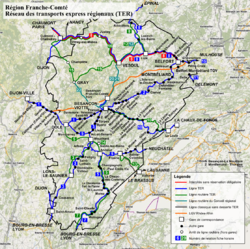| TER Franche-Comté | |||
|---|---|---|---|
 | |||
| Overview | |||
| Website | http://www.sncf.com/en/trains/ter | ||
| Technical | |||
| Track gauge | 1,435 mm (4 ft 8+1⁄2 in) standard gauge | ||
| |||
TER Franche-Comté was the regional rail network serving the Franche-Comté région, France. In 2017 it was merged into the new TER Bourgogne-Franche-Comté.
Since the convention signed in 2002 for a duration of 5 years, between Jean-François Humbert, then president of the Regional council of Franche-Comté and Noël Belin, then regional director of the SNCF, the regional council of Franche-Comté is the organising authority of regional transports. A new agreement, signed on 21 December 2006, by Raymond Forni, president of the Conseil Régional de Franche-Comté and Josiane Beaud, regional directeur of the SNCF, en présence d'Anne-Marie Idrac, présidente of the SNCF, from 2007 to 2012.
TER railway connections[edit]

| Line | Route | Frequency | Notes |
|---|---|---|---|
| 1 | Dijon ... Dole ... Besançon-Viotte | ||
| 2 | Besançon-Viotte ... Montbéliard ... Belfort | ||
| 3 | Besançon-Viotte ... Mouchard ... Lons-le-Saunier ... Bourg-en-Bresse | ||
| 4 | Dole ... Mouchard ... Frasne ... Pontarlier | ||
| 5 | Besançon-Viotte/Dole ... Mouchard ... Champagnole ... Morez ... Saint-Claude | ||
| 8 | Vesoul – Lure ... Belfort | ||
| 9 | Nancy ... Épinal ... Lure ... Belfort (see TER Lorraine line 5 for details) | ||
| 10 | Besançon-Viotte ... Valdahon ... Morteau ... La Chaux-de-Fonds (Switzerland) | ||
| † Not all trains call at this station | |||
- The two lines Dijon–Dole–Besançon and Besançon–Montbéliard–Belfort essentially form one line, called the Saône–Doubs line. It constitutes the backbone of trips in Franche-Comté with 60% of the passengers and 60% of the Gross profit. It's along this route that the line bypasses highwayss, canals and other railways.
- The Revermont line: Besançon–Lons-le-Saunier–Bourg-en-Bresse. Second line by its importance, is, for a large part, a single track (between Saint-Amour and Mouchard).
- Besançon–Morteau–La Chaux-de-Fonds : this line has been certified by French normes in 2005. The trains on this line are usually done with SNCF Class X 73500 and SNCF Class X 2800, though occasionally they are upgraded to SNCF Class XR 6200.
- Belfort–Épinal
- Dijon–Pontarlier
- Dole–Saint-Claude: this line is called the ligne des hirondelles (line of swallows)
- Montbéliard–Belfort–Vesoul
- Morez–Bourg-en-Bresse–Lyon
Rolling stock[edit]
Multiple units[edit]
- SNCF Class Z 9500
- SNCF Class Z 9600
- SNCF Class X 2800+ trailers SNCF Class XR 6000
- SNCF Class X 4750
- SNCF Class X 73500
- SNCF Class X 76500 (also called: XGC X 76500)
- SNCF Class Z 27500 (also called: ZGC Z 27500)
Locomotives[edit]
See also[edit]
External links[edit]

Well, that’s interesting to know that Psilotum nudum are known as whisk ferns. Psilotum nudum is the commoner species of the two. While the P. flaccidum is a rare species and is found in the tropical islands. Both the species are usually epiphytic in habit and grow upon tree ferns. These species may also be terrestrial and grow in humus or in the crevices of the rocks.
View the detailed Guide of Psilotum nudum: Detailed Study Of Psilotum Nudum (Whisk Fern), Classification, Anatomy, Reproduction